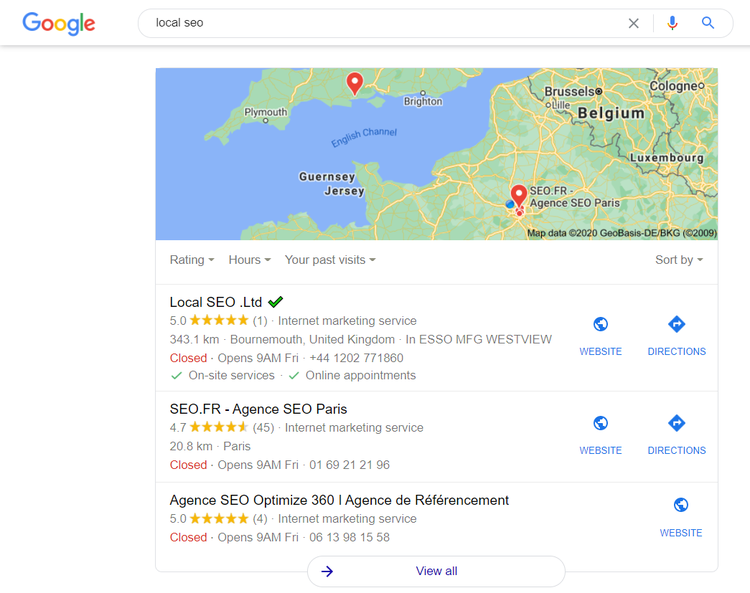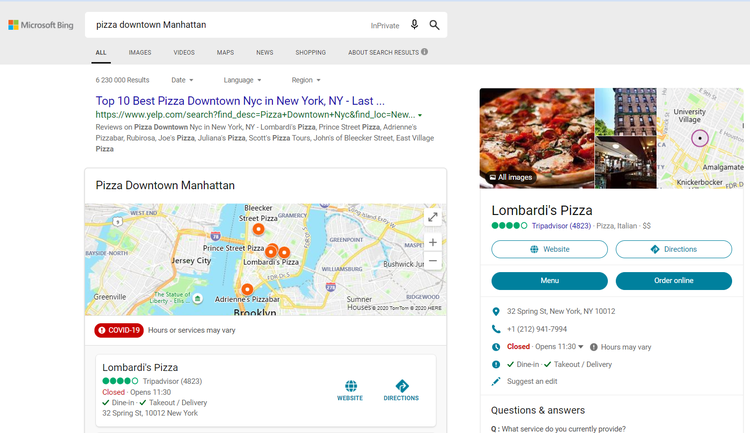"This will be the year of mobile" was a standing joke at search marketing conferences in most of the 2010s. Everyone saw the rise of mobile usage, but the usefulness of mobile targeting seemed to lag behind significantly. Boy, has that changed in 2020.
Users are mobile, judged by the proportion of searches done on mobile, search results are personalized to your position, and Google even uses a principle called "Mobile first" for crawling and indexing websites.
To understand what that means, let's take the example of a person looking for "pizza.” When you type "pizza" on your desktop computer, what does that mean?
Maybe you are looking for recipe ideas or take-away services. But typing "pizza" on your smartphone means something totally different. Something like: "I want pizza now, where can I get it?" And search results will show you restaurants serving pizza close to your physical location. Hungry yet?
Overview: What is local SEO?
Local SEO is about optimizing search engine visibility for mobile internet users and for geographical searches. Yes, we have two approaches here: one is in contextual search results and the other is at the keyword level, where you will be targeting "pizza + ", where "town" will be the one your pizza restaurant is based in. Easy, right?

In this search for "local SEO,” you can see 3 agencies who have worked on optimizing their appearance in Google's local pack. Image source: Author
How does local SEO differ from other types of SEO?
Search engines are becoming better and better at meeting users' expectations. They have advanced tremendously in the personalization of search results. A local SEO strategy is not as clear cut as a more general SEO strategy. Traditional SEO combined with local SEO can drive further results. Let's look at some more characteristics of local SEO below.
Footfall rather than clicks
SEO for a local business is about bringing tangible results rather than visibility. For most local businesses, that means getting people into the shop rather than traffic on their website.
Difficult to monitor
What is a local search? Well, it can be a search via a smartphone where sites appear in a "local pack," which is a personalized content block including a map and local links to nearby results based on the GMS coordinates of the user.
Or it can be a generic search on a desktop computer for a keyword and a location qualifier. I am searching for a gym in a specific neighborhood. Or it can be a search carried out from within a search engine's maps application while a user is at a specific location. It is easy to track "gym + neighborhood", but it’s difficult to track the other two searches.
Not so much about the site
The goal of local SEO is footfall (the number of people entering a store or shopping area in a given time) to your shop, the site is not always your most important asset. In Google SERPs, the Google My Business (GMB) profile of your shop will more easily appear in the local pack. That is where you need to be optimized with the right keyword and make sure you have chosen the right category and the right address.
Difficult to benchmark
Measuring footfall is more difficult than measuring online traffic. And tying a physical visitor to online actions can be challenging as well. Google analytics can do this to some extent with the "store visits" tracking, but it isn’t precise. It becomes almost impossible to compare your local SEO results with other sites. Are your results good or bad? Difficult to tell.
5 strategies for optimizing for local SEO
"Strategies" is perhaps a stretch for the local SEO tips we present below. It’s not a step-by-step process to optimize for local SEO, rather it’s work in various dimensions that can be done simultaneously.
1. Build local company profiles
Your first stop is a Google My Business profile. It’s similar to a Facebook business page, an Amazon Brand Store, or a LinkedIn business profile, which you should also create. It’s a page hosted by Google with all your business details. It can show your business hours, and it can appear on Google Maps when users are looking for directions. There is also a Bing equivalent, the Bing Places for Business profile.
Next, claim your profile or create it from scratch on YELP, Apple Maps, Yellow Pages, Foursquare, and Yahoo Localworks. Outside of North America, local business directories and yellow pages are sometimes paired directly or indirectly with the search engine to provide local results.
Bing sometimes shows Tripadvisor, Foursquare, and Facebook profiles in their search results. The more robust business profiles you have, the better. They’re your backdoor into the local search results pages.

Search engines use contextual information and partnerships to serve the results that correspond the best to the supposed intent of the user query. Image source: Author
2. Optimize for local packs
Several factors come into play to gain a spot in the highly-coveted local pack, the personalized search results pages including local results. The distance from the searcher’s location to the business address is the first, and the keyword or category the search corresponds to is the second. But a third factor comes into play as well: reviews and ratings.
Getting more difficult, isn't it? You need to have good products, offer great service, create a great user experience, and be sure that is reflected in your ratings.
3. Name and address consistency
I live on a street called Rue Eiffel. It was named after the guy who built the Eiffel Tower, Gustave Eiffel. Unfortunately, half of the map providers for GPS systems have it as Rue Gustave Eiffel, and the other half as Rue Eiffel. I have had countless problems with delivery services abandoning delivery or cab drivers not being able to take me home -- simply because the guy was too famous, so someone added his first name.
The same challenge appears in your local SEO: make sure your business name, address, and phone number are always identical to the smallest detail in all your profile entries. If not, the profiles won't match up and search engines will get confusing signals, meaning you risk not showing up in search results.
4. Local backlinks
Backlinks are one of the most important factors for SEO. And for local SEO, there is such a thing as local backlinks. If you are in a local business directory, mentioned in a local press site, or perhaps in a community site related to a specific geographical location, this can reinforce the localness of your business and strengthen your positioning. It’s a good idea to build these backlinks as they will help your overall SEO strength.
5. Local keyword qualifiers in your content
Now we come to your website content. You are using your business address consistently as mentioned in point three, but you can do more. Your address belongs to an area within a town or a city in a region and in a country. Depending on how users search for your type of business, these words can be important. If you have done no keyword research before your local SEO project, it’s time to get going.
You can use a free keyword tool to look up the main queries surrounding your product or service category and your area. Beware, however, that the queries you are looking for may not appear as they represent too few searches. This doesn't mean people don't use them, though. You need to be creative and think about your end users. How will they search for your service? What words will they use to designate your area?
The name of a major street, an area code, a train station, an area name, a town name? You can search for these words with a keyword tool, one of the various SEO tools, or simply look them up in a search engine to see what appears. Then you combine them with your main product or service keyword, or even your brand. And make sure you have a page on your website which talks about "pizza in downtown Manhattan.”
Your local SEO checklist
By addressing the points above, you will have addressed the main tasks for your local SEO. Let's check whether you've got it all covered with the local SEO checklist below:
- Claim and create company profiles on search engines
- Create company profiles on social networks
- Register in business directories, yellow pages
- Build backlinks for sites with a local focus
- Use company name and address consistently on website and everywhere else
- Use location information and keywords in website content
Local SEO is about the customer experience
There is traditional SEO, and then there’s local SEO. If you have done traditional SEO, that can help, but local SEO is a different set of techniques, where you focus less on your site and more on the general user experience of people you could drive to your physical location.
It involves creating consistent and attractive business profiles for maps and specific location-centric content. It depends highly on the quality of your products or service and the experience users get at your location. Tend to that before anything else.
Our Small Business Expert
We're firm believers in the Golden Rule, which is why editorial opinions are ours alone and have not been previously reviewed, approved, or endorsed by included advertisers. The Ascent, a Motley Fool service, does not cover all offers on the market. The Ascent has a dedicated team of editors and analysts focused on personal finance, and they follow the same set of publishing standards and editorial integrity while maintaining professional separation from the analysts and editors on other Motley Fool brands.